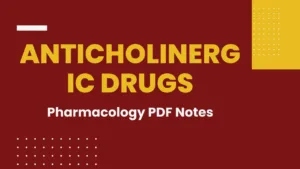Anticholinergic Drugs

Content
ANS
• Anticholinergic drugs
• Pharmacology of atropine
• Atropine poisoning and its treatment
At the end of this lecture, student will be able to
• List the anticholinergic drugs
• Explain the pharmacology of atropine
• Explain atropine poisoning and its treatment
Anticholinergic drugs (Parasympatholytics)
Muscarinic Receptor Blockers
• Atropine & related alkaloids from Atropa belladonna
Belladonna Alkaloids
• Atropine (dl – hyoscyamine)
– Ester of tropic acid + Tropine
• Scopolamine (Hyoscine)
– Ester of tropic acid + Scopine
MOA of Atropine
• Block peripheral and central effects of Ach
• Competitive antagonism
• Dose for M blockade varies from organ to organ
• Salivary, bronchial secretion – extremely sensitive
• Vagal stimulation: Not completely abolished
• Large doses: NN Blockade
Differences between Atropine and Scopolamine
| Atropine | Scopolamine |
| CNS stimulation | CNS depression |
| More active on heart, gut, bronchial smooth muscle | Prominent effects on iris, ciliary body, salivary, bronchial, sweat secretion |
| Longer duration | Shorter |
Pharmacological Actions of Atropine
• Secretion: Decreases (except milk)
• Salivary: Dryness of mouth, difficulty in swallowing
• Gastric: Decrease volume and acidity, mucous and gastric enzymes
• Other secretions:
– Bronchial secretions become viscid
– Inhibits sweat secretion
– Not significant on lacrimal secretion
Pharmacological actions of Atropine on smooth muscle
• GIT: Decreases tone and motility, Antispasmodic
• Biliary tract: Weak antispasmodic
• Urinary tract: Decreases ureteral peristalsis, urinary retention
• Bronchi: Relax bronchi and bronchioles, dries up secretion
• Uterus: No significant effect
Pharmacological actions of Atropine on eye
• Mydriasis (Blocks cholinergic nerves of sphincter if iris)
• Photophobia (Sphincter paralysis)
• Ciliary smooth muscle paralysis – cycloplegia
• No changes in i.o.t in normal individuals
• In narrow angle glaucoma: increases
• Due to relaxation of ciliary muscle and crowding of iris
Pharmacological Actions of Atropine on CVS
CVS
• Initially decreases HR – ++ of vagal nuclei
• Tachycardia: X of M2 R in SA node
• Counters the vasodilation and hypotension of cholinergic agents
• Toxic dose: Dilation of cutaneous blood vessels – atropine flush+ hypotension
Pharmacological Actions of Acetylcholine on CNS
Atropine
• Mild + of medullary vagal nuclei & higher cerebral centers
• Produces bradycardia and increase rate, depth of respiration
Scopolamine
• Depress RAS
• Euphoria, drowsiness, amnesia, dreamless sleep
• Motion sickness (Vestibular function)
ADME
• All route: Satisfactory absorption
• From eye, intact skin: Not significant
• Partly detoxified by liver, partly unchanged
• Cross placental barrier, sec in milk and saliva
• Excreted through urine
ADR
• Infants, children – CNS toxicity
• Elderly – Glaucoma, urinary retension
• Locally – Allergic dermatitis, conjunctivitis, swelling of eyelids
• Mild – Xerostomia, flushing, constipation
• Acute atropine poisoning
• Children: 10-20 mg, Adults: 80 – 130 mg
• Wide margin of safety
Acute Atropine Poisoning
Peripheral blockade
• Dry mouth, difficulty in swallowing, intense thirst
• Tachycardia, palpitation, flushing
• Hyperpyrexia
• Dilation of pupils, blurred vision, photophobia
• Urinary urgency, difficulty in micturition, urinary retention
• Rash – Face, neck, upper part of trunk
Acute Atropine Poisoning – Mydriasis
Central effects
• Initial stimulation subsequent depression
• Excitement, restlessness, motor in co-ordination
• Slurring of speech
• Disturbance of memory, confusion, hallucination
• Severe poisoning: Depress vasomotor centre
Treatment of Atropine poisoning
• Gastric lavage
• Universal antidote
• Slow IV – physostigmine (1 – 4 mg) – cross BBB
• SC – neostigmine (2-5mg)
• Restlessness, delirium – Diazepam
• Darkroom – photophobia
• Catheter – for urinary retention
• Tepid sponging – pyrexia
Therapeutic uses
• Gastrointestinal colic
• Ocular conditions
• Preanesthetic medication
• OPC poisoning
• PD
• To abolish AV block
• Urinary incontinence
• Motion sickness
Contraindications
• With caution: above 40 years (Acute angle glaucoma)
• Enlarged prostate – urinary retention
• Chronic lung diseases
• CHF with tachycardia
Frequently Asked Questions
- Are all anticholinergic drugs associated with cognitive decline?
- Understanding the nuances of cognitive effects.
- Can anticholinergic medications be stopped abruptly?
- Exploring the challenges and recommended withdrawal strategies.
- What are some natural alternatives to anticholinergic drugs?
- Exploring lifestyle changes and natural remedies.
- How do regulatory guidelines ensure the safety of anticholinergic prescriptions?
- Understanding the role of regulations in healthcare.
- Where can I find more resources on anticholinergic drug research?
- Exploring reliable sources for up-to-date information.
Summary
• Block peripheral and central effects of Ach
• Atropine (dl – hyoscyamine)
– Ester of tropic acid + Tropine
– Mild stimulation of medullary vagal nuclei & higher cerebral centers
• Scopolamine (Hyoscine)
– Ester of tropic acid + Scopine
– Depress RAS
For Detailed PDF Notes Click on Download Button
